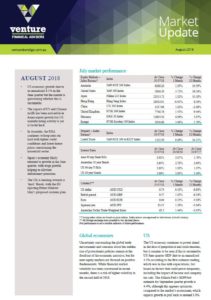
The Pulse
- US economic growth shot to an annualised 4.1% in the June quarter but the market is questioning whether this is sustainable.
- The impact of US and Chinese tariffs has been noticeable in Asian export growth but US manufacturing activity is yet to be hit hard.
- In Australia, the RBA continues to keep rates on hold with tighter credit conditions and lower house prices constraining the household sector.
- Japan’s economy likely returned to growth in the June quarter, with wage growth helping to alleviate deflationary pressures.
- The UK is heading towards a ‘hard’ Brexit, with the EU rejecting Prime Minister May’s proposed customs plan.
Global economies
Uncertainty surrounding the global trade environment and concerns about the sudden rise of protectionist policies remain at the forefront of the economic narrative, but for now equity markets are focused on positive fundamentals. While financial market volatility has been constrained in recent months, there is a risk of higher volatility in the second half of 2018.
Australia
Given the risks within the household sector, the RBA is happy to sit on the bench, holding rates at 1.50% at its August meeting. While household debt and sluggish wage growth remain a concern, the business sector is enjoying favourable conditions, especially in the manufacturing, construction and business services industries.
US
The US economy continues to power ahead in the face of geopolitical and trade tensions, but it remains to be seen if this is sustainable. US June quarter GDP shot to an annualised 4.1% according to the first estimate reading, which was in line with expectations, but based on factors that could prove temporary, including the impact of income and company tax cuts.
Europe
Despite improved labour market flexibility and ongoing structural reform, the eurozone economy is yet to show signs of sustained growth. According to a preliminary estimate, GDP growth across the euro member countries was 2.1% year-on-year at end June, down from 2.5% in the March quarter and continuing to pull back from the higher rates of growth seen in 2017, which were underpinned by strong export performance.
China
The latest round of Chinese data provides evidence of a further slowing in manufacturing activity, while the services sector is lifting its contribution to growth. The June quarter GDP data showed economic growth easing back to 6.7%, with the services sector growing by 7.6%, highlighting the evolution of the Chinese economy.
Asia Region
In Japan, manufacturing and services PMIs indicated a moderate slowing in activity, with the headline Business Activity Index falling 0.1 points to 51.3. Japanese exports rose 6.7% in June, but exports to the United States—Japan’s largest trading partner—fell for the first time in 17 months in signs that the US-China tariff war is starting to have some spillover effects in neighbouring markets.